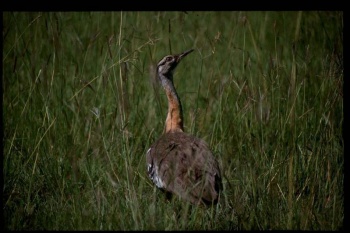Alternative name: Stanley Bustard
- Neotis denhami
Identification
80–100 cm (31½-39½ in)
- Brown upperparts
- White underparts
- Pale grey neck with an orange nape
- Black crown stripes
- Pale yellow legs
- Brown, white and black wings
Female has lighter brown upperparts and shows less white in the wings when flying
Distribution
Sub-Saharan Africa
Western Africa: Mauritania, Senegambia, Senegal, The Gambia, Guinea-Bissau, Mali, Sierra Leone, Liberia, Ivory Coast, Burkina Faso, Ghana, Benin, Nigeria, Niger, Niger, Chad, Congo, Democratic Republic of Congo, Angola
Eastern Africa: Sudan, South Sudan, Kenya, Uganda, Rwanda, Burundi, Tanzania, Zambia, Mozambique, Malawi
Southern Africa: Zimbabwe, South Africa, KwaZulu-Natal, eSwatini
Taxonomy
Subspecies
There are 3 subspecies1:
- N. d. denhami:
- South-western Mauritania and Senegambia to northern Uganda and Ethiopia
- N. d. jacksoni:
- N. d. stanleyi:
- eSwatini and South Africa
An additional subspecies burchelli is not recognised by most authorities2
Habitat
Grasslands and savanna; open ground, including agricultural land, flood-plains and burnt fynbos.
Status
Classified as Near Threatened in the 2008 IUCN Red List.3
Behaviour
They have a very varied diet which includes insects, small vertebrates and plant material.
Breeding
The male inflates his throat to display a globe of white feathers
Polygynous; no evidence of territoriality. One to two eggs are laid on the ground in a small open space between grass tufts, forbs, shrubs or rocks; incubated for 23-25 days by the female.
References
- Clements, J. F., T. S. Schulenberg, M. J. Iliff, D. Roberson, T. A. Fredericks, B. L. Sullivan, and C. L. Wood. 2017. The eBird/Clements checklist of birds of the world: v2017, with updates to August 2017. Downloaded from http://www.birds.cornell.edu/clementschecklist/download/
- Avibase
- Handbook of the Birds of the World Alive (retrieved May 2018)
- BirdLife International
- Wikipedia
Recommended Citation
- BirdForum Opus contributors. (2025) Denham's Bustard. In: BirdForum, the forum for wild birds and birding. Retrieved 9 May 2025 from https://www.birdforum.net/opus/Denham%27s_Bustard






